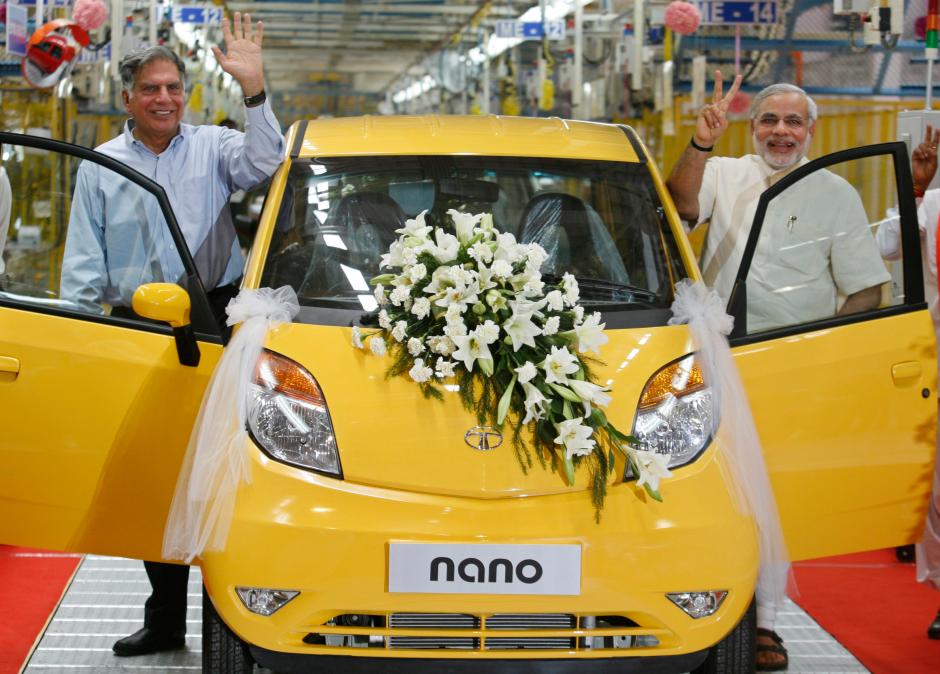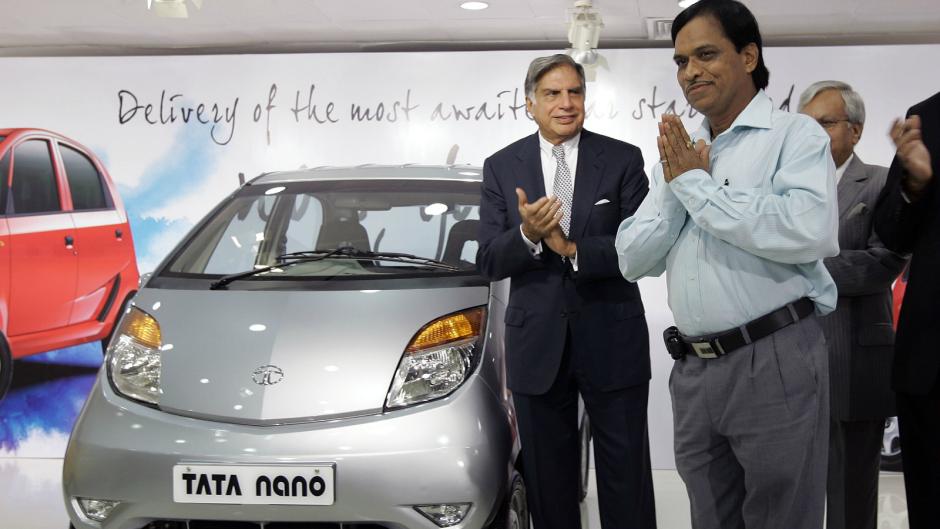‘Tata Nano: The Cheapest Car in The World’
These were the headlines in the newspapers around the world. The world was perplexed, amazed, excited, all at the same time. An Indian company had come up with the cheapest car in the world. Tata Motors achieved this feet.
But how?
Tata Nano was finally up there in showrooms, ready to be sold. The Tata Motors was elated by their achievement. However, the circumstances were never in Tata’s favour. What went wrong? Why did the Tata Nano fail? Was it a bad idea? Or a good idea, badly executed? Let’s find out.
Suggested For You: The TATA Sumo | India’s Legendary People Mover
The Story Behind Nano | Tata Nano

The entire concept of the Tata Nano was conceived by Ratan Tata. In November 2003 Ratan Tata saw a family of four on a scooter. It was raining and the family was somehow managing and adjusting themselves on the two-wheeler.
This incident moved Tata so immensely, that he took it on himself to come up with a safer alternative for this. He wanted the country to move around in a safer mode of transport.
“Today’s story started some years ago when I observed families riding on two-wheelers. The father driving a scooter, his young kid standing in front of him, his wife sitting behind him holding a baby. I asked myself whether one could conceive of a safe, affordable, all-weather form of transport for such a family,”. This is what Tata said while launching the Tata Nano in New Delhi.
Specifications | Tata Nano
The powertrain of the Nano was a 624CC SOHC petrol, rear engine and rear-wheel car with a manual gearbox that gave a very commendable 25 kilometres per litre. The in-city mileage of the car stood at a decent 15-17 kilometres per litre. This 642 cc engine produced 37 bhp of power churning out 51 Nm of torque.
The Tata Nano stood at 3164 mm long, with a width of 1750 mm at a height of 1652 mm. It offered a ground clearance of a decent 180 mm.
Where Did the Price Go? | Tata Nano

The first question everyone had in their mind after hearing about the Tata Nano was – “How?”. No one was able to digest the fact that the entire car was available for just ₹1 lakh.
The company had to play strategically to keep the prices near the ₹1,00,000 mark and yet make it good enough to be termed as a ‘car’. Tata decided to cut on all the unnecessary parts on the vehicle.
- Using just one windscreen wiper instead of two
- Removing airbags altogether which however hampered the safety
- Providing a thinner and lighter spare tire.
- Making the fuel inlet only accessible through the front hood
- Adding a single wing mirror instead of two
Now, this might not feel like enough, but it did the job. All these deductions made the Tata Nano quite similar to the Alto, which was more expensive.
You Might Also Like: Tata Indica | India’s first indigenously developed passenger car
What Went Wrong?
Ratan Tata’s rainy day idea did have a gloomy ending at the end. The sales of the car never reached above the positive mark. In January 2008, Ratan Tata said he was well aware of the steep increase in input prices of steel, tyres and other sundry inputs that might lead to an increase in the final price of the car. However, he went ahead with the initial price of ₹ 1 lakh because it was a promise he had made to the people.
Here are some of the reasons, we feel that might have led to the failure of the Nano.
‘Cheapest Car’ Tag
Tata took the price-sensitive nature of the Indian markets too seriously. The Nano was manufactured with an intention to cater to the lower-middle class segment of the country. The people for whom Nano might even be their first car.
However, in all this enthusiasm, Tata didn’t realise the negative publicity it gathered. The word ‘cheap’ was being related to ‘low quality’. This shooed away many potential customers from the stigma of buying the ‘cheapest car in the world’. Marketing the car as ‘India’s national mover’ or ‘The Real People’s Car’ or something on those lines might have worked wonders for the company.
Production & Delivery
Tata’s planning and strategy turned into shambles. The company was about to start production in West Bengal’s Singur. Everything was set and ready to go. However, this didn’t bode well with many well-wishers of the state. The acquisition of land for the factory sparked widespread protests around the state.
This hampered Tata’s delivery and production schedule. Tata had to ultimately move their production to Gujarat. Even after travelling across the country, things didn’t go well. The plant in Sanand, Gujarat was not able to meet the demands due to the slow production rate. So, Tata deteriorated their own sales over here.
Poor Build Quality
Tata did try to get the best of both worlds here but failed miserably. The overall build quality of the Tata Nano was not at all up to the mark. At 635 kg it lacked bulk to be on roads. The tyres were way too small which wasn’t in tune with the Indian roads.
Adding to this the mysterious fires added to the woes of Tata Motors. many customers complained of mysterious fires in their car. The fires occurred due to the faulty electrical equipment linked to the exhaust, this was clarified in a statement by Tata.
To top that, the company’s customer service wasn’t up to the mark as well. Many people complained of a lethargic response by the customer service team of the company, which detested the people from buying the Tata Nano.
Not The Cheapest Car
Technically, the Tata Nano was never a ₹1 lakh car. The car breached the lakh mark with the addition of VAT and other taxes. This was rather a paradox for the customers.
Seeing the ‘cheapest car’ tag fail miserably, the company tried to sell it as the ‘youngster’s car’. But the damage had already been done. By the time Tata decided to reposition the Nano, the car had attached with itself an image it couldn’t shed off. Ever.
Conclusion

Yes, the car was supposed to bring a revolution. Maybe, somewhat on the lines of the Maruti 800. Ratan Tata had an ambitious dream of providing a safer means of transport to every Indian.
However, the project never failed, the circumstances did. The lower than ever margins of Tata portrayed their goodwill. Maybe, it was never supposed to turn profitable or to bring in big bucks for Tata Motors. Maybe, it was just a testament of Tata to truly work for the betterment of the country.
Whatever the reason might be, the Nano did leave a mark on the automotive industry.
Also Read: Top 10 Automobile Companies In India






Vocal for focal
I love TATA vehicles
Price range very low
I love india
I have now kwid chenge to altroz
Hi,
Glad to know that your next vehicle will be from Tata. Altroz is a pretty good choice.
Stay tuned!
I love Tata and good car Tata Nano but Tata Nano to 2021 not available for Tata sowroom 😟 please Lunch 2021 Tata Nano mini car
Superb car Tata Nano. Tall boy stance and though looks small from outside very spacious inside , even more than other bigger engine hatchbacks . Nice sitting position with commanding view of the road in front. Feel like u r sitting in the cockpit of a helicopter. Easy to manovour and drive and small size makes it easy to park in tight spots. An engineering marvel from Tata motors. Those who criticise it have unrealistic expectations , this lead to its decline.
Launch nano only automatic l was proud owner of one
I already have a Tata nano and consider himself a part of Tata. The 2013 models was without power steering, if some changes possible to adopt power steering in same vehicle I think most persons opt not to change and will remain in this nano platform and nano will revive again.
Hi Daniel
We cannot agree more about the fact that Nano was actually a VFM car. Congratulations on owning the Lakhtakiya car.
Do Visit us if you ever want to get your dear machine serviced!
Nano is simply superb for a middle class family, easy to ride in traffic, decent milage of 17 km on city and nearly 25 km on long drive. Nice front view, more comfortable sitting, parking is not at all a matter at any place, if you really need a car 🚗 in traffic City, Nano the best No1 car. I believe owners are very proud of their Nano.
Cheers to the legendary Nano!